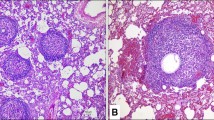Summary
Many strains of the complex “Hartmannella-Acanthamoeba” and “Naegleria” amebae could be isolated from cold-blooded vertebrates, especially reptiles. The morphology of the nucleus and the size of these amebae separate them distinctly from the classical genus Entamoeba. In many cases the “Hartmannella” were associated with typical amebae of the genus Entamoeba, but we could see such infections also were the Hartmannella-types, were not mixed with other amebae. In spite of that we found the characteristic amebic alterations of the tissue. It is to conclude that these amebae have a pathogenic capability against the reptile tissue. In six cases the brain was also infected. A number of strains were isolated from feces only and no clinical symptoms could be observed. These observations may be important for the epidemiology at least in such cases were amphibians and reptiles have contact to unchlorinated swimming pools or in which these animals are kept as pets. — Pathogenicity against warm-blooded vertebrates is not tested as yet.
Zusammenfassung
Aus einer großen Anzahl von Kaltblütern, insbesondere Reptilien, wurde eine Reihe von Amoebenstämmen isoliert, die auf Grund von Größe und Kernstruktur dem Typus „Hartmannella-Acanthamoeba“ und „Naegleria“ zuzuordnen sind. Häufig traten diese Amoeben bei Reptilien zusammen mit typischen Entamoeben auf. In den Fällen, in denen nur „Hartmannella“ gefunden wurden, lag aber bei der Mehrzahl der Tiere ebenfalls eine charakteristische Amoebiasis vor, so daß anzunehmen ist, daß auch diese Amoeben pathogene Eigenschaften gegenüber dem Reptilgewebe besitzen. Besonders zu erwähnen ist, daß auch das Gehirn besiedelt werden kann. Kotuntersuchungen lieferten aber auch den Beweis, daß klinisch gesunde Tiere diese Amoeben beherbergen können, ein Befund, der für die Epidemiologie von Bedeutung sein kann. Inwieweit diese Amoeben eine Pathogenität dem Warmblüter gegenüber besitzen, ist noch ungeklärt.
Similar content being viewed by others
Literatur
Bosch, I.: „Hartmannella“-Infektionen bei Fröschen. VI. Tagg. DGP Hannover 10.–12. 4. 1972(a).
Bosch, I.: Infektionsversuche beim Warmblüter mit „Hartmannellen“ aus Kaltblütern. Z. Parasitenk. (in Vorbereitung) (1972b).
Bosch, I., Deichsel, G.: Morphologische Untersuchungen an pathogenen und potentiell pathogenen Amoeben der Typen „Entamoeba“ und „Hartmannella-Acanthamoeba“ aus Reptilien. Z. Parasitenk. 40, 107–129 (1972).
Bosch, I., Frank, W.: Beitrag zur Gefrierkonservierung pathogener Amoeben und Trichomonaden. I. Z. Parasitenk. 38, 303–312 (1972).
Braun, R.: Massenzucht von Entamoeba invadens als Basis für immunologische Untersuchungen. Diplomarbeit Universität Hohenheim 1971.
Culbertson, C. G.: The pathogenicity of soil amebas. Ann. Rev. Microbiol. 25, 231–254 (1971).
Culbertson, C. G., Ensinger, P. M., Overton, W. M.: Pathogenic Naegleria sp.—Study of a strain isolated from human cerebrospinal fluid. J. Protozool. 15, 353–363 (1968).
Culbertson, C. G., Smith, J. W., Cohen, H. K., Minner, J. R.: Experimental infection of mice and monkeys by Acanthamoeba. Amer. J. Path. 35, 185–197 (1959).
Culbertson, C. G., Smith, J. W., Minner, J. R.: Acanthamoeba: Observations on animal pathogenicity. Science 127, 1506 (1958).
Derrick, E. H.: A fatal case of generalized amoebiasis due to a protozoon closely resembling, if not identical with Jodamoeba bütschlii. Trans. roy. Soc. trop. Med. Hyg. 42, 191–198 (1948).
Frank, W.: Entamoebiasis bei Reptilien. Z. Parasitenk. 25, 22–24 (1964).
Frank, W.: Generalisierte Amoebiasis bei einem Leguan (Iguana iguana) (Reptilia, Iguanidae), hervorgerufen durch Entamoeba invadens (Protozoa, Amoebozoa). Z. Tropenmed. Parasit. 17, 285–294 (1966).
Frank, W., Bosch, I.: Isolierung von Entamoeben des Typs „Hartmannella“ aus Reptilien. J. Parasit. 56, 421 Nr 757 (1970).
Geiman, Q. M., Ratcliffe, H. L.: Morphology and life cycle of an amoeba producing amoebiasis in reptiles. Parasitology 28, 208–228 (1936).
Editor: Med. J. Austr. 1, 1036–1038 (1969).
Hill, W. C. O., Neal, R. A.: An epizootic due to Entamoeba invadens at the Gardens of the Zoological Society of London. Proc. Zool. Soc. (Lond.) 123, 731–737 (1953).
Ippen, R.: Die Amoebendysenterie der Reptilien. Kleintierpraxis 4, 131–137 (1959).
Jahnes, W. G., Füllmer, H. M., Li, C. P.: Free living amoebae as contaminants in monkey tissue culture. Proc. Exp. Biol. Med. 96, 484–488 (1957).
Kernohan, J. W., Magath, T. B., Schloss, G. T.: Granuloma of brain, probably due to Endolimax williamsi (Jodamoeba bütschlii). Arch. Path. 70, 576–580 (1960).
McConnell, E. E., Garner, F. M., Kirk, J. H.: Hartmannellosis in a bull. Path. Vet. 5, 1–6 (1968).
Ratcliffe, J., Geiman, Q. M.: Spontaneous and experimental amebic infection in reptiles. Arch. Path. 25, 160–184 (1938).
Richards, C. S.: Two new species of Hartmannella amebae infecting freshwater molluscs. J. Protozool. 15, 651–656 (1968).
Rodhain, J.: Entamoeba invadens n. sp. Parasite de serpents. C. R. Soc. Biol. (Paris) 117, 1195–1199 (1934).
Rodhain, J., Hoof, M. Th. van: Note préliminaire sur le rôle pathogéne d'Entamoeba invadens chez les serpents. C. R. Soc. Biol. (Paris) 117, 1199–1200 (1934).
Singh, B. N., Das, S. R.: Studies on pathogenic and nonpathogenic small free-living amoebae and the bearing of nuclear division on the classification of the order amoebida. Phil. Trans. B 259, 435–476 (1970).
Skoćil, V., Cerva, L., Serbus, C.: Epidemiological study of amoebae of the Limax group in military communities. J.Hyg. Epidem. (Praha) 14, 61–66 (1970).
Steck, F.: Amoebendysenterie bei Reptilien. Zbl. Bakt., I. Abt. Orig. 181, 551–553 (1961).
Steck, F.: Pathogenese und klinisches Bild der Amoebendysenterie der Reptilien. Acta trop. (Basel) 19, 318–354 (1962).
Steck, F.: Die Amoebendysenterie der Reptilien Aetiologie, Epidemiologie, Diagnostik und Bekämpfung. Acta trop. (Basel) 20, 115–142 (1963).
Author information
Authors and Affiliations
Additional information
Nach brieflicher Auskunft von Prof. Dr. W. Balamuth (Univ. of California, Berkely) handelt es sich bei dem an ihn gesandten Stamm 2 um eine Naegleria-Art.
Durchgeführt mit Mitteln der Deutschen Forschungsgemeinschaft.
Rights and permissions
About this article
Cite this article
Frank, W., Bosch, I. Isolierung von Amoeben des Typs „Hartmannella-Acanthamoeba“ und „Naegleria“ aus Kaltblütern. Z. Parasitenk. 40, 139–150 (1972). https://doi.org/10.1007/BF00329149
Received:
Issue Date:
DOI: https://doi.org/10.1007/BF00329149




